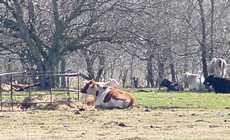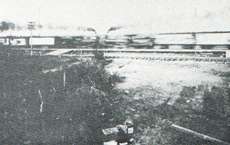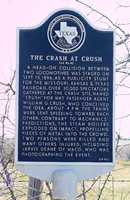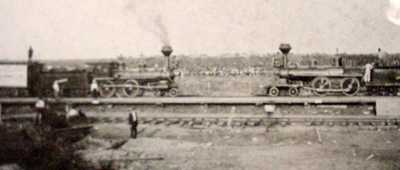The Crash at Crush. (original) (raw)
Book by
MIKE COX
Order Here
The field that once was Crush, Texas is now occupied by cows, but a recently replaced historical marker south of West, Texas tells the story of one of the most bizarre publicity stunts of all time.

The site as it appeared in February of 2004
TE Photo
It was a slow day at the office and George Crush, a passenger agent for the Katy railroad was thinking about train wrecks and how they never failed to draw a crowd. George knew that even the slightest collision would have people coming from far and near to see derailments, explosions and steam-scalded victims.
If accidents drew crowds of hundreds, how many would come to a deliberate, heavily publicized crash? Agent Crush bet the numbers would be in the thousands, but no one in Texas in the 1890s was stupid enough to take the bet. They knew better.
George ran the idea up the MKT flagpole and his superiors saluted it. The railroad laid a spur off their main tracks north of Waco in September of 1896. A four mile spur with a grandstand, press offices, a bandstand and a "depot" marked Crush, Texas.
The "Monster Crash" was advertised for months in advance and newspapers kept readers updated on preparations. Two obsolete engines were given a reprieve from the scrap furnaces and reconditioned to the point where they could build up a good head of steam. Painted in contrasting red and green, and pulling boxcars covered in advertising, the locomotives were like aged gladiators painted with cosmetics for one final battle where both would lose. They were displayed in various towns before the event and people all across Texas were hoping they would live long enough to witness the event.
The half-town, half-carnival that became Crush, Texas was set up with restaurants, game booths and "lemonade" stands. Some of the latter even sold real lemonade!
The railroad had offered two dollar round-trip tickets from anywhere in the state and the first of thirty-three excursion trains began arriving at dawn on September 15, 1896. Some of the trains arrived with passengers riding al fresco - on top of the cars. Approximately 40,000 men, women and children were given until late afternoon to spend their money and be subjected to the speeches of politicians, the warnings of prophets and the light fingers of pickpockets.
The few trees on the site had boys hanging in them like noisy fruit. Children sat on their father's shoulders and ladies were politely asked to remove their hats. At 5:00 p.m. the engines nosed toward each other and "shook hands" like prizefighters before backing into position.
Agent Crush, riding a borrowed white horse, threw down a white hat as a signal and got out of the way. The engines headed toward one another while the crowd roared their approval over the locomotive's death-whistles.
The Event Unfolding
Photo Courtesy The Texas Collection, Baylor University

The Crash
Photo Courtesy The Texas Collection, Baylor University

The Aftermath
Photo Courtesy The Texas Collection, Baylor University
Railroad officials had taken the precaution of asking their best mechanics about the chances of the two boilers exploding. The officials were reassured that it would never happen. But, the mechanics were wrong and the boilers exploded on impact, sending shrapnel into the crowd and killing several spectators. A hot bolt was sent through the eye of a Waco photographer (who miraculously survived).
Those not carried away by ambulance or hearse went home to brag to their friends and relatives that couldn't scrape together the two-dollar fare. Railroad cranes removed the big iron and souvenir hunters took away the smaller pieces. By nightfall, all that was left was mud, red and green chunks of iron and pools of used lemonade.
The Katy did have some claims by irate relatives of the victims, but refunds, cash payments and lifetime passes took care of them. A lifetime railroad pass in the 1890s was like winning the lottery. George Crush was fired (with a wink) and was rehired as soon as the press moved on to other disasters. Some accounts say that he was given a bonus.
Although the "town" only existed for a day, the event was certainly remembered by the local residents. This photo shows two boys in 1935 - with the photo identified as being "near Crush, Texas."
Ragtime composer Scott Joplin commemorated the event a few years later with "The Great Crush Collision." It wasn't one of his most memorable tunes and it was left out of the soundtrack for The Sting. Fortunately, though, contemporary composer, singer and Last Texas Troubadour Brian Burns, was inspired enough by the event to record his song about the collision in 2001.
Mr. Burns unique specialty is blending Texas history and music. Playing to schools (where he says the students inspire him as much as he inspires them), events and venues, he leaves behind enthusiastic audiences and a rapidly growing following.
�
John Troesser March 28, 2004 Column
Reprinted in the Bricolage Truth - December 2014 THE ACCIDENT ISSUE (http://www.bricolagetruth.com)
 |
The recently replaced Historical Marker Location A few miles South of West, Texas (North of Waco, South of Hillsboro) on the I-35 service road (East side of the highway) TE Photo, February 2004 |
|---|
Historical Marker: A head-on collision between two locomotives was staged on Sept. 15, 1896, as a publicity stunt for the Missouri, Kansas & Texas railroad. Over 30,000 spectators gathered at the crash site, named "crush" for MKT passenger agent William G. Crush, who conceived the idea. About 4 p.m. the trains were sent speeding toward each other. Contrary to mechanics' predictions, the steam boilers exploded on impact, propelling pieces of metal into the crowd. Two persons were killed and many others injured, including Jarvis Deane of Waco, who was photographing the event.
(1976)
Crash at Crush Forum
Subject: Crash at Crush
General Passenger Agent William 'Bill' Crush, of the Missouri-Kansas-Texas Railroad -- the Katy -- was the first to stage a collision between locomotives, but far from the last. For several years prior to the Crash at Crush, Broadway shows had been simulating railroad crashes on stage, together with sparks, fire, and steam. A man known as 'Head-on Joe' staged collisions at fairs from a few weeks after the Crush show until the 1920s. The last deliberately-staged collision of steam locomotives was filmed for the movie Denver & Rio Grande, when two former D&RGW narrow-gauge locomotives were crashed on former D&RGW (by then Durango & Silverton) narrow-gauge tracks in Colorado. One boiler exploded, so it's fortunate the crash was filmed with telephoto lenses. - C. F. Eckhardt, May 10, 2006
Texas Escapes, in its purpose to preserve historic, endangered and vanishing Texas, asks that anyone wishing to share their local history, stories, landmarks and recent or vintage photos, please contact us.
